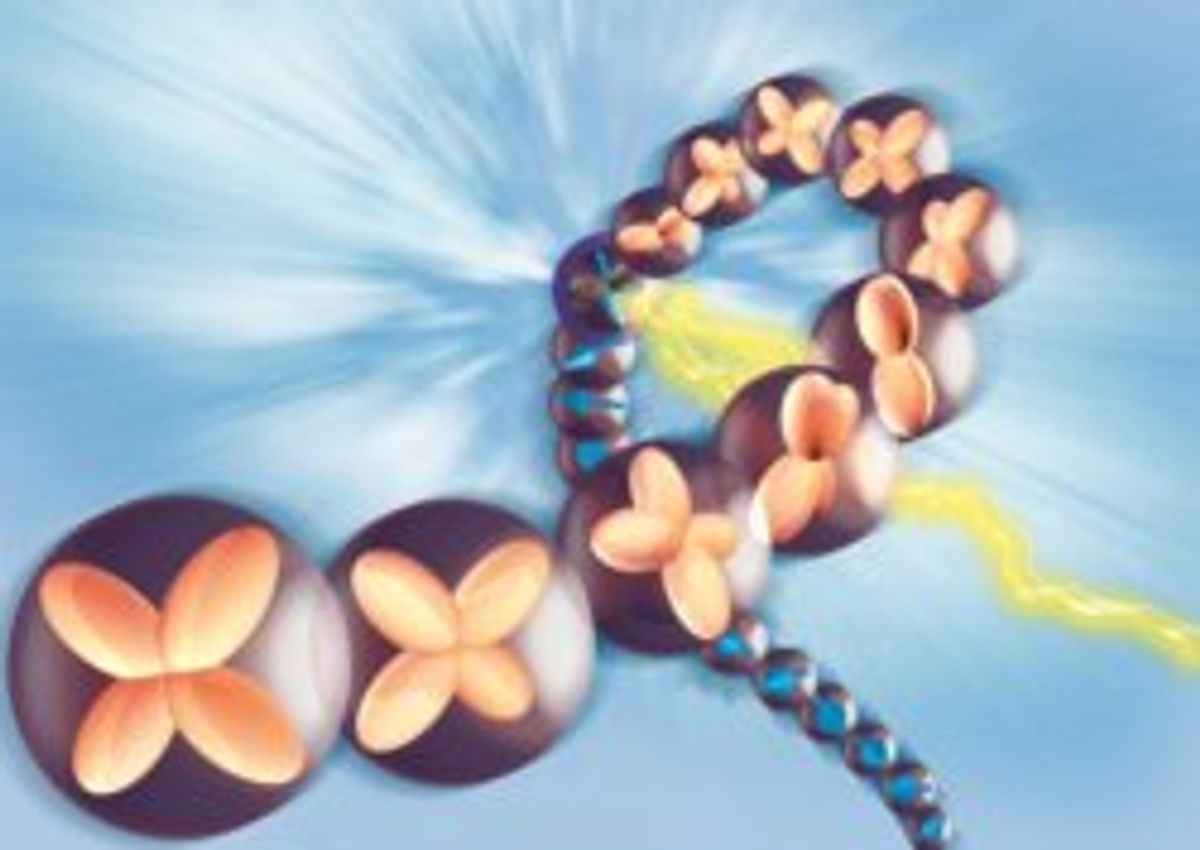When football fans stand and sit for “the wave,” they collectively create something new—a “quasiparticle” with properties all its own. Emergent entities like this are common in materials: Think of the hole in a semiconductor, which behaves like a positively-charged particle but is really just a stand-in for the absence of an electron. Now, the quasiparticle zoo is expanding. Last month, researchers reported evidence of two new sorts of particle-like entities. They could have implications for quantum computing and superconductivity.
One quasiparticle came from “splitting” the electrons in a one-dimensional chain of molecules. Theorists have long suspected that electrons placed in such a confined system will divide into three quasiparticles, each described by one fundamental electron property: “Holons” carry charge, “orbitons” carry the electron’s orbital state, and “spinons” carry the quantum property of spin. Scientists have already seen the holon and the spinon. But in April, Thorsten Schmitt of the Paul Scherrer Institute in Villigen, Switzerland, and his colleagues reported evidence of both the spinon and the orbiton, which were made by zapping a sample of strontium cuprate with X-rays. Because of the similarities between strontium cuprate and copper-based superconductors, the researchers suspect orbitons will help shed some light on the physics of high-temperature superconductivity.
April also brought news of a stand-alone quasiparticle: the peculiar Majorana fermion. The particle-physics zoo is full of particle-antiparticle pairs like the electron and its antimatter partner, the positron. But in the 1930’s, the Italian physicist Ettore Majarona predicted a curious outlier—an electrically neutral cousin of electrons and protons that is its own antiparticle.
Physicists have yet to find signs of this self-annihilating particle inside particle accelerators, but they think they’ve found its cousin in solid materials. A team led by Leo Kouwenhoven of the Delft University of Technology, in the Netherlands, saw strong hints of Majoranas when they sent electrons into a semiconducting nanowire placed alongside superconducting material (the team’s produced this nice animation of the set-up). Like the orbiton system, the nanowire is a confined environment where electrons combine to produce an emergent state: in this case, what seems to be an electrically-neutral particle on either end of the wire that blocks the flow of electrons unless they’re of a certain energy.
“Many leading experimental groups have been trying to detect some signatures of Majorana fermions, but [the] Delft experimental results are the most convincing so far,” says Roman Lutchyn, a researcher at Microsoft’s Station Q in Santa Barbara, Calif., who, along with a few colleagues, outlined how such an experiment might be able to produce Majorana particles in 2010.
But Lutchyn notes that more work needs to be done before a discovery can be definitively declared. One key test, he says, will be to confirm the exchange statistics of the particles. These statistics describe how the quantum mechanics of the system changes when two indistinguishable particle switch places. In most physical systems, the many-particle wavefunction (the core quantum description of a system which is used to calculate the probability of a certain measurement) stays exactly the same or changes sign when you swap particles. But Majoranas are not so neatly symmetric. When two Majoranas switch places, the state of their collective wavefunction changes.
This property makes Majorana particles an attractive system for quantum computing, because it offers a way to encode information that – unlike current quantum computing systems – isn’t easily disrupted by thermal fluctuations. That said, performing computations this way is likely still very much on the horizon. “[Such] proposals are tantalizing but in my opinion relatively far from realization,” says Marcel Franz of the University of British Columbia in Vancouver. “There are several challenges to overcome here, including how to move Majoranas around in a controlled fashion and how read out the result of such a computation.”
Even so, other research teams are in the race or soon will be. One team, led by David Goldhaber-Gordon at Stanford University, has reported hints of Majorana fermions in a system consisting of two pieces of superconducting material connected by a topological insulator.
Meanwhile, freestanding versions of the Majorana—one not confined to a particular material—are still at large, and a variety of particle physics experiments, including the Large Hadron Collider are looking for them. New Scientist posted a good round-up of the possibilities – which include neutrinos, supersymmetric versions of the Higgs particle, and dark matter candidates – in this article, posted to the web on Monday (available behind a registration wall).
Illustration: David Hilf
Rachel Courtland, an unabashed astronomy aficionado, is a former senior associate editor at Spectrum. She now works in the editorial department at Nature. At Spectrum, she wrote about a variety of engineering efforts, including the quest for energy-producing fusion at the National Ignition Facility and the hunt for dark matter using an ultraquiet radio receiver. In 2014, she received a Neal Award for her feature on shrinking transistors and how the semiconductor industry talks about the challenge.



